Forest Salvation
Air Date: Week of June 12, 2009
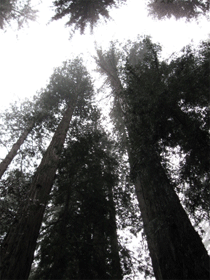
California redwoods (Photo: Ingrid Lobet)
Trees can soak up carbon dioxide, one of the major greenhouse gases, from the air. Now, California has created one of the first regulated methods for landowners to make money by growing more trees, more quickly, and other states are following suit. Living on Earth’s Ingrid Lobet reports on how forests can help landowners provide part of the solution to climate change.
Transcript
YOUNG: It’s Living on Earth, I’m Jeff Young.
CURWOOD: And I’m Steve Curwood. We continue now with another in our ongoing series of stories about connections between changing forests and the disruption of the earth’s climate.
The burning and felling of forests is perhaps releasing one fifth of all greenhouse gases. The United Nations is trying to protect tropical forests – through REDD – the UN program on reducing emissions from deforestation and forest degradation. But the carbon balance of temperate forests also affects the climate, and that’s where California comes in. Living on Earth’s Ingrid Lobet has our story on a new exchange created to make it worthwhile for forest operators to increase carbon storage on their lands.
LOBET: On the rural highways of California's redwood country, horse trailers share the road with organic coffee delivery vans. From inside his truck, Chris Kelly points at a small grove of tall redwoods in a state park.
KELLY: This is what the whole North Coast used to look like. Big, big huge trees, widely spaced, lots of understory. But this is now increasingly rare.
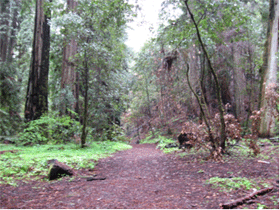
Redwoods in a California state park. Most old growth has been cut for timber over the last 60 years. (Photo: Ingrid Lobet)
KELLY: It is remarkable and this all happened really since the 70s when Robert Mondavi put California on the map. Even now it seems there is no end in developing undeveloped land into vineyards.
LOBET: That's a concern for Kelly. He's the California director for the Conservation Fund, a group that looks for intact or salvageable ecosystems to buy and protect.
The iconic large trees were the most valuable ones here. With most of them gone, owners of forestland are more likely to subdivide if they need money, selling off acres here and there.
KELLY: If there are some parcels that have coastal views, they sell those off for coastal development. For some that have potential value as vineyards, they sell those off. The result being is that over time we see the fragmentation of the landscape into myriad individual ownerships, each with their own house, each with their own septic system, each with their own domestic animals and all of a sudden the fabric of these watershed breaks down.
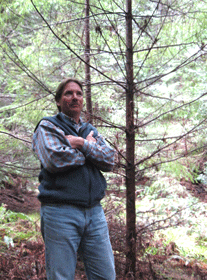
Chris Kelly, California Director of the Conservation Fund. (Photo: Ingrid Lobet)
[SOUND OF WATER RUNNING, BIRDS]
KELLY: We are standing at the top of the ridge, looking west to the Pacific Ocean. So everything you see 360 degrees from here is part of our ownership. And that sound you hear in the background is the North Fork running pretty strong, after two or three days of rain.
LOBET: It's beautiful; the air is clean. We're surrounded by trees.
KELLY: It's 24,000 acres. It comprises a third of the Garcia River watershed. It has spotted owl, it has Coho salmon, it has steelhead trout, and it has this rich mix of redwood and Douglas fir forest. So when we had the chance to buy it we jumped at the chance.
LOBET: About that same time the Conservation Fund acquired this property, California was beginning to inventory its carbon emissions in its efforts to address climate change.
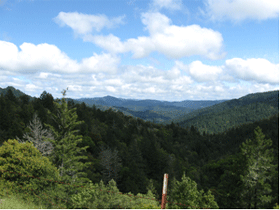
A view of the Garcia River Forest, where the Conservation Fund now owns 24,000 acres. (Photo: Ingrid Lobet)
Forest groups and forest owners pushed the legislature to create rules to legitimize this emerging market. Gary Gero is president of the non-profit California Climate Action Reserve.
GERO: The most perhaps prominent was Pacific Forest Trust in San Francisco -- The Nature Conservancy was also very active in that debate, the forest industry as well.
LOBET: California officials designated the Reserve as the arbiter of forest carbon in the state. So they convened all the interested parties to figure out what was going to qualify for forest credits.
It wasn't easy, but they quickly agreed only land that was originally forested could qualify. And only native trees would count.
And they turned to an expert who had spent years in the woods and then years on computer models for some of the technical work.
NICKERSON: My name is John Nickerson and I am a forester. My business is called Dogwood Springs Forestry.
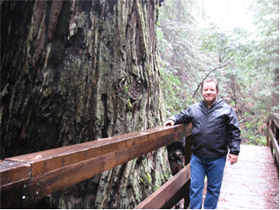
Forester John Nickerson uses computer models to predict the amount of carbon uptake in trees.
NICKERSON: So for each five-year period we have an estimate of the volume of trees, the species that will be there, the size the species and their density and from that we are able to compute carbon values. So we do the modeling approach for baseline and then for our anticipated project activities and the difference between the two is a reduction, and can be traded as an offset.
LOBET: The models Nickerson and the Climate Action Reserve use now can estimate amounts of carbon stored in a forest in five-year increments, comparing different land use scenarios.
Perhaps the stickiest question for the Reserve was how long a landowner must commit to keeping the trees standing, storing the carbon. At first the answer was… forever. Again Gary Gero.
GERO: In our first protocol we guaranteed that permanence through the conservation easements. So you were required to have a permanent conservation easement on your land to make sure the project was permanent.
LOBET: But that requirement caused the commercial timber industry to drop out of negotiations.
GERO: A lot of private landowners told us and public landowners frankly told us that that was not a mechanism they were willing to put on their land for forever.
LOBET: Recently a new version of the California forestry carbon rules was released, and the idea of permanence has now been eased.
GERO: We look at the half life of carbon in the atmosphere is about 100 years, and so we say that you need to maintain trees that are sequestering carbon, for 100 years.
LOBET: Gero says many companies still find this too strict, but this time they have signed on.
GERO: I know I met with Mendocino Redwood company recently: They told me they have been a company for ten years. It is very hard for them to imagine signing a 100-year contract.
LOBET: And any landowner who then wants to sell their land has to find a buyer willing to abide by that 100-year contract or else pay back all the credits. Finally, the Reserve also had to figure what do in the case of fire. Fire can be beneficial or catastrophic, but when there's a contract to preserve a forest for a century, fire becomes a legal risk.
GERO: All projects contribute into an insurance pool. So if there is a fire on any given project, we would take credits out of this insurance pool to ensure the ongoing permanence of those reductions.
LOBET: Once an owner has counted the trees on the ground and the computer models have output their projections, the Reserve sends an independent company out to verify data by taking tree measurements. That company also checks assumptions in the growth models. If everything checks out, the Climate Action Reserve then issues the landowner one certificate for every ton of carbon he or she has sequestered.
GERO: For instance we'll have a forest project that could be issued 100 thousand tons of credits, essentially 100 thousand tons of CO2 equivalent emissions that have been sequestered. We issue serial numbers for each and every ton, so it is akin to minting a new commodity -- this commodity is an emissions reduction that has a unique serial number. And those tons are then placed in the account of the forest owner. And they are fungible like any other commodity, that they are free to sell or to retire on behalf of the environment or hold onto in hopes of selling then in the future at a higher cost.
LOBET: The very first credits verified by the Climate Action Reserve were issued last December. And the Conservation's Fund's project on the Garcia River was one of the recipients, which says Chris Kelly, meant acting as sort of a guinea pig.
KELLY: I liken our work to get this forest verified as like driving a train on a track that is still being built. Every once in a while you get to a point where they are still laying the track and you're not sure which way to go.
LOBET: But finally the verification was over and the day came.
KELLY: So what we got was an email saying "we have just posted to your reserve account 78,000 tons of the Garcia River Forest for 2007."
LOBET: That meant the environmental group now had an account holding 78,000 Climate Reserve Tons, also known as carrots, worth about $8.00/apiece.
[BIRDS SINGING]
LOBET: Back in the Garcia River forest, Mike Stephens, a wildlife biologist, is looking for a pair of spotted owls he's been watching. He's concerned that some unusual weather may have disrupted their nesting.
STEPHENS: We are at the base of their nest tree. There is this clump of small diameter redwoods.
[BIRDS SINGING]
LOBET: As the trees in this forest mature, the hope is there will be more habitat for the endangered owls.
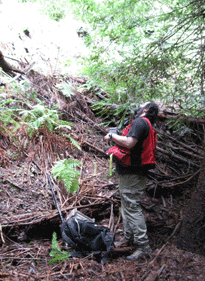
Biologist Mike Stephens searches for spotted owls by imitating their contact call. (Photo: Ingrid Lobet)
[BIRDS SINGING AND SOUND OF SMALL MAMMALS MOVING]
LOBET: Stephens has brought mice as bait and makes the sounds of prey. He waits, but no response. So he reluctantly makes a call like another owl in the territory.
[OWL CALL]
LOBET: And swiftly a large shadow passes over us and we can hear them, the pair of owls, talking to each other.
[OWLS CALLING BACK AND FORTH]
LOBET: It's a little surprising the owls chose to nest in this young tree. But the Garcia River forest doesn’t have much in the way of old growth to offer. Chris Kelly of the Conservation Fund explains that because of successive logging, this forest is what you might call a fixer upper.
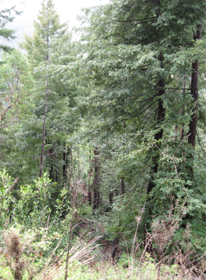
Young trees in a crowded forest.
KELLY: What we have is a thicket of young trees all struggling and competing for air and light. Whereas in a mature forest you might have 30 trees per acre, we have 300 trees per acre and so as a consequence they are all struggling to grow and none of them are growing very effectively--it's like an over-planted garden.
LOBET: To move the forest mix toward more mature trees, spaced more widely, the group has been cutting smaller trees and selling them for timber. They also need the timber money to pay for repairs after 60 years of commercials logging.
KELLY: On this 25,000-acre forest, we have 220 miles of dirt road, innumerable culverts and stream crossings, thirteen bridges. The roads need to be maintained every year to keep sediment from getting into the river; the bridges are at the end of their useful life and need to be replaced. So a fixed, irreducible cost of management. So, we thought why not have the forest help us, help it recover?
LOBET: To cut their timber they use a labor intensive, individual tree cutting process called cable-yarding.
KELLY: One end of the clothesline has a motorized pulley and then the other end of the clothesline is down in the valley or is across the valley and then you string a cable from the clothesline to the ground and then you can lift individual trees up in the air and retrieve them with the clothesline.
LOBET: This selective logging is not only making money and helping the forest mature more rapidly, the carbon-audit process for the Garcia River shows it's also increasing the rate of carbon storage.
KELLY: Ironically by us going in and selecting out some of the slower growing weaker trees and creating space for the more vigorous trees to grow, we are increasing the rate of carbon sequestration in the forest.
We have modeled the carbon accumulation in the forest over a twenty-year period. If we would just leave it alone, and we have modeled the carbon accumulation in the forest if we do the single tree selection, and we found that we get to twenty percent or more carbon sequestered in a twenty year period than had we done nothing.
LOBET: And just practically speaking the way this happens is, you remove a tree that is crowded. The sun shines down and allows more of what trees need to grow to the remaining tree, and its growth actually outperforms or outweighs what those two trees would have had if you hadn't cut the one?
KELLY: Exactly, one because now there is one tree growing with the nutrients and the space that two trees had to share and because the tree we took was the less vigorous, less productive tree.
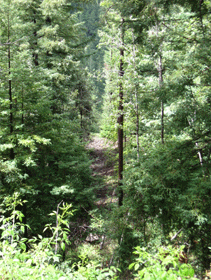
A corridor used for logging using cable yarding. (Photo: Ingrid Lobet)
KELLY: I would say that on the Garcia River forest our net annual income has doubled as a result of our ability to sell carbon offsets. If we were not enjoying the carbon revenue, then we wouldn't be able to put people to work this summer doing some of the restoration work improving the roads fixing the bridges.
LOBET: So carbon income is going to be fixing the forest this summer.
KELLY: Carbon income is going to be fixing the forest this summer. And the next and the next is my expectation.
LOBET: Kelly points out a paradox that is felt everywhere in the world where people are talking about forest carbon. The forests that are most depleted, most mistreated, sometimes have the most potential for absorbing carbon out of the atmosphere quickly.
KELLY: All of the carbon was wrung out of the forest, released into the atmosphere and in some cases into wood products, but now these young forests are like a sponge ready to soak up carbon for the next 100 years. So the forests are here to serve us in a very different way than they served us in the last century.
LOBET: He marvels that in the redwoods at least, the main income from carbon increase should come over the next 30 to 50 years, as the trees are getting big quickly. Just as that income is set to taper off, you could begin to selectively take large trees out of the forest again, and make real money from the timber.

California redwoods.
LOBET: Forest landowners aren't the only ones taking notice of this new source of income. No sooner had those carbon credits been deposited into the account of the Conservation Fund, then the phone began ringing. Wall Street investors wanted to buy them. They're betting the price will go up once the United States passes a cap on carbon emissions. Pacific Gas and Electric wants carbon credits to offer to its customers who wish to offset their personal energy emissions.
Back at the California Climate Reserve Gary Gero says these credits have already given birth to a new industry: businesses known as "forest project developers".
GERO: And what we are seeing now is that there are a number of companies out there that are specializing in investing in forest projects to obtain the carbon credits for them at a very economic return. So they invest perhaps 1 million dollars into a project, get the carbon credits at something close to four or five dollars a ton it costs them to generate those credits, knowing they can sell those credits at a higher rate later.
LOBET: The Reserve has just finished writing rules to certify credits in forests outside of California. They've been asked to verify projects in Georgia, Oregon and Pennsylvania.
Ultimately many people believe the world needs to change its fuel and energy sources to address greenhouse gas emissions. Gero and forest carbon experts say the role for trees is to tide us over until that day.
GERO: While we’re waiting for renewable energy to take hold and be the dominant energy source, forest management can start today because it doesn't require any new technology, it doesn't require anything more than a commitment to manage forests differently. And if you can manage forests better to increase sequestration in a way that is credible and permanent, you should get some credit for that and that can help bridge the gap to the new energy economy.
LOBET: In other words, the tree rush is on. For Living On Earth, I'm Ingrid Lobet, in Mendocino County, California.
CURWOOD: for more information about forests and climate change, check out our web site: loe.org.
[MUSIC] “Love Will Tear Us Apart” from Dept Of Good And Evil (Savoy Jazz 2007)
YOUNG: Just ahead the little sub that could. Stay with us - on Living on Earth.
Links
Living on Earth wants to hear from you!
Living on Earth
62 Calef Highway, Suite 212
Lee, NH 03861
Telephone: 617-287-4121
E-mail: comments@loe.org
Newsletter [Click here]
Donate to Living on Earth!
Living on Earth is an independent media program and relies entirely on contributions from listeners and institutions supporting public service. Please donate now to preserve an independent environmental voice.
NewsletterLiving on Earth offers a weekly delivery of the show's rundown to your mailbox. Sign up for our newsletter today!
 Sailors For The Sea: Be the change you want to sea.
Sailors For The Sea: Be the change you want to sea.
 The Grantham Foundation for the Protection of the Environment: Committed to protecting and improving the health of the global environment.
The Grantham Foundation for the Protection of the Environment: Committed to protecting and improving the health of the global environment.
 Contribute to Living on Earth and receive, as our gift to you, an archival print of one of Mark Seth Lender's extraordinary wildlife photographs. Follow the link to see Mark's current collection of photographs.
Contribute to Living on Earth and receive, as our gift to you, an archival print of one of Mark Seth Lender's extraordinary wildlife photographs. Follow the link to see Mark's current collection of photographs.
 Buy a signed copy of Mark Seth Lender's book Smeagull the Seagull & support Living on Earth
Buy a signed copy of Mark Seth Lender's book Smeagull the Seagull & support Living on Earth

